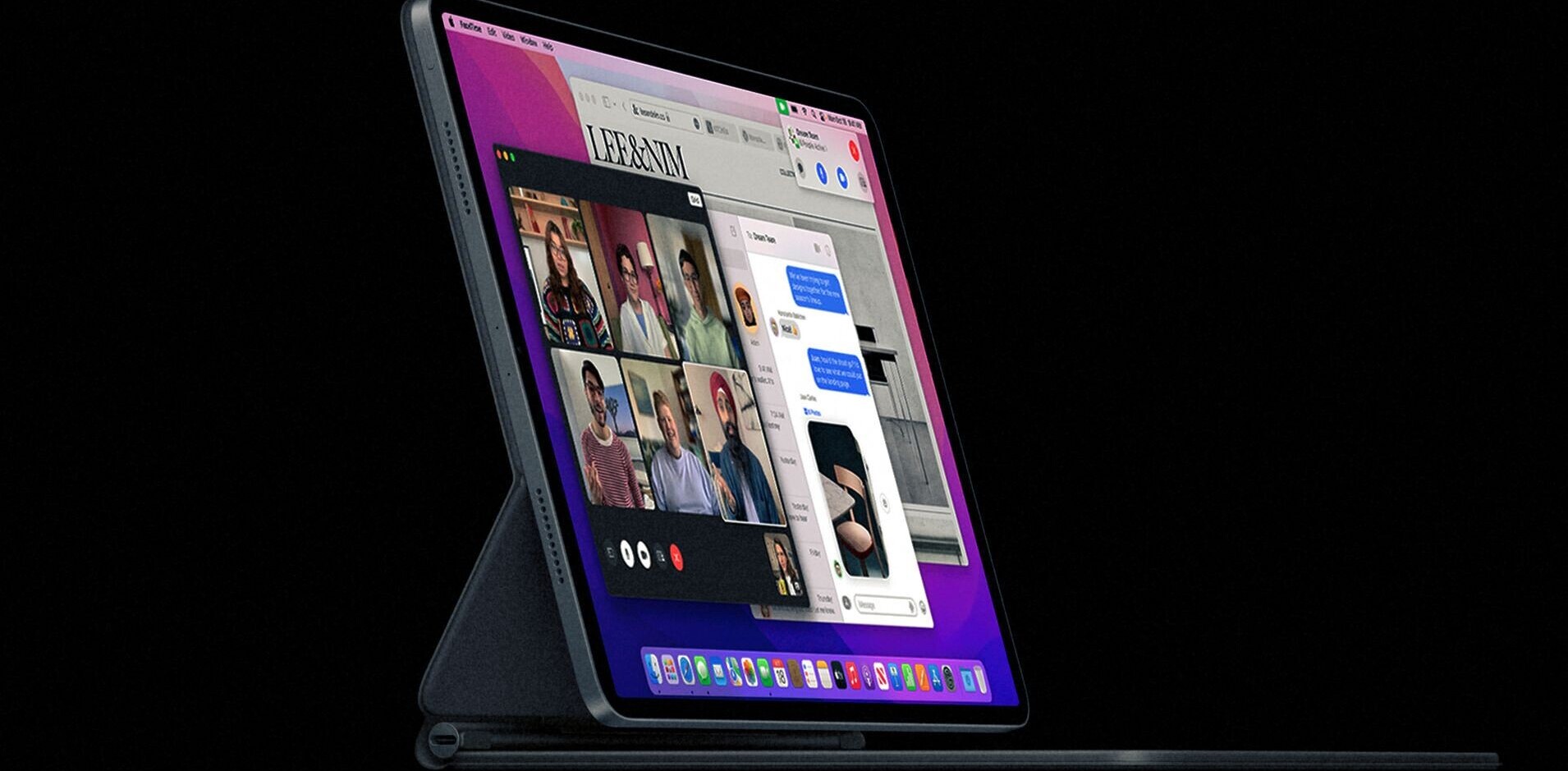I’m a sucker for a portable speaker. Of all the technological advances in recent years, they’re up there with the best. So when the Sonos Roam was announced I was — as the kids say — #Down2Clown.
And you know what? It’s good. Really good. But the Sonos Roam goes beyond its technical characteristics; it’s also shrewd business move from the company.
We were so excited about this that we put a WHOLE DAMN VIDEO together about it. You can watch that here or at the top of the page. (And while you’re at it, how about you subscribe to our channel too?).
But… do you dislike watching things with your eyes? Prefer the written word? Don’t worry, friend — there’s a full article below that both reviews and analyzes the Sonos Roam.
First things first…
Who the hell are Sonos?
If you’re reading this it’s likely that you already know Sonos, but there’s nothing wong with a quick refresher, right?
Basically, the company produces multi-room audio equipment. This includes a gamut of hardware, such as the Sonos Move (a less portable speaker than the Roam), the Sonos Arc (a soundbar), the Sonos One (a compact powered speaker), and many, many more.
The idea underpinning Sonos’ gear is it provides an easy way to produce seamless sound across your entire house. Want to listen to uninterrupted music between the living room and the toilet? Sonos can help.
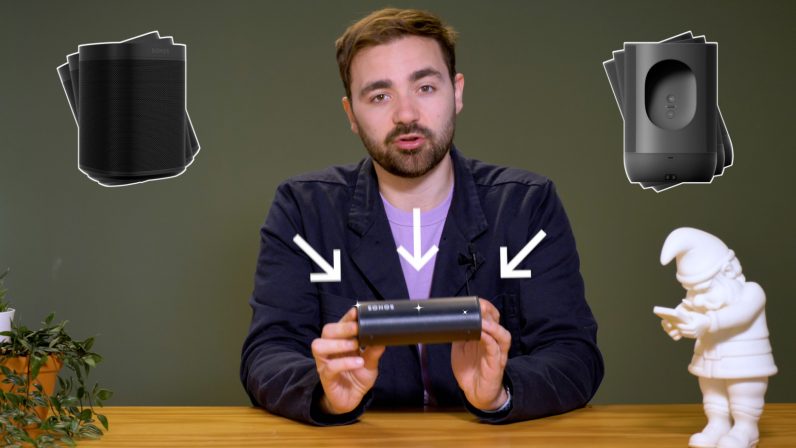
And is Sonos equipment any good?
If you asked me five years ago I would’ve said “no, not really.” Then probably something like “who are you and why are you asking and can you get out of my house?”
But things have changed.
I’d put this down to three main factors: Sonos upping its game, the improving quality of basic networking equipment, and better audio standards like AirPlay 2 and Bluetooth 5.
Where once I found Sonos equipment glitchy and overpriced, my current view is the company makes solid music hardware that works pretty damn well.
So tell us about the Sonos Roam
It’d be my pleasure. First, here’s a nice picture:

The Sonos Roam is a super portable speaker that costs $170. It’s around 17cm tall and weighs about 430g — about the same as a standard tin of tomatoes. In other words, it’s heavy enough to feel premium, but light enough to chuck in your bag and not notice it.
It’s also IP67 rated, which means it has water and dust resistance, and can be immersed in up to one meter of clean water for 30 minutes.
Battery-wise, Sonos says it can last for up to 10 hours on a single charge, something I found broadly accurate, but slightly disappointing. A portable speaker of this size should last a few hours longer.
In regards to charging, the Sonos Roam does it via USB-C (woo!) or a Qi-enabled wireless chargers. Sonos also sells its own version of the latter, which looks like this:
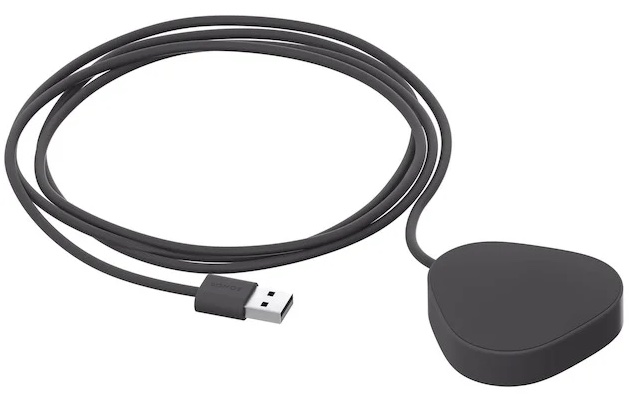
When you’re ready to actually play some music, you have a variety of delicious options. This includes Bluetooth, WiFi, the Sonos app, and AirPlay 2. Basically, you’re spoilt for choice.
Want all that summed up in an easy-to-read image? Well, you’re in luck:
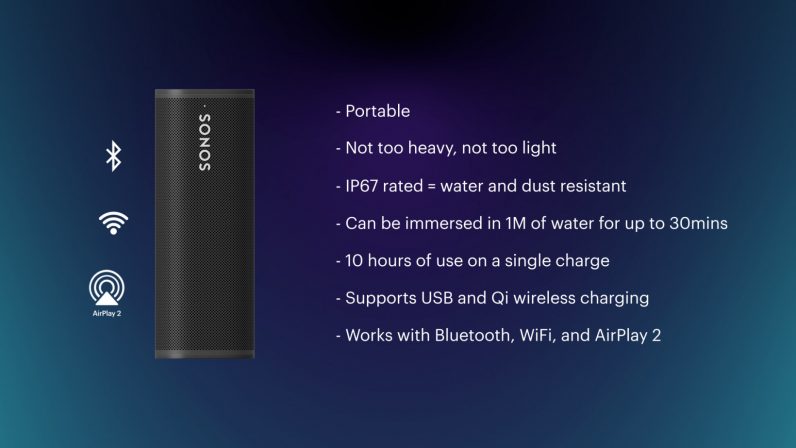
Is this the part of the Sonos Roam review where you tell us what you think?
You got it, pals.
Overall, I’m impressed. The build-quality of the Sonos Roam is solid. It has the look and feel of a premium bit of technology, rather than the rough-and-ready workhorse you get from many other portable speakers.
The Sonos Roam feels sturdy enough to survive being bashed in your backpack, but I do question how good its fancy aesthetic will look after it has been scuffed up for several months.
Ideally, the speaker would’ve come with a carry case of some variety. I’d probably recommend you picking one up if you’re constantly taking it out and about.

But let’s talk about sound.
The Sonos Roam exceeded my expectations. The portable speaker is teensy-tiny, but delivers a bigger and more detailed sound than I anticipated.
Of course, you’re not going to get audiophile-quality noise out of something this size, but that doesn’t mean it’s bad.
In my testing, I found the bass has a pleasant, meaty thump. But the Sonos Roam is really about the mids. This makes sense, as it sounds as thought it’s been tuned as a party speaker, putting vocal ranges and bass to the fore.
This is further reinforced when you consider the slightly dulled trebles the Sonos Roam has a habit of producing. This isn’t bad per se — there’s little worse than listening to music outside and cymbals cutting through everything — but it does show the limitations of the device.
Effectively, the Sonos Roam is lacking a certain level of detail and clarity, but not enough that it ever overshadows your enjoyment of the music.
In terms of other criticism, I’d like a bit more oomph from the speaker, but more on that later.
So I was going to sum it up? The Sonos Roam’s sound is solid and sensible, precisely what you want from a portable speaker.
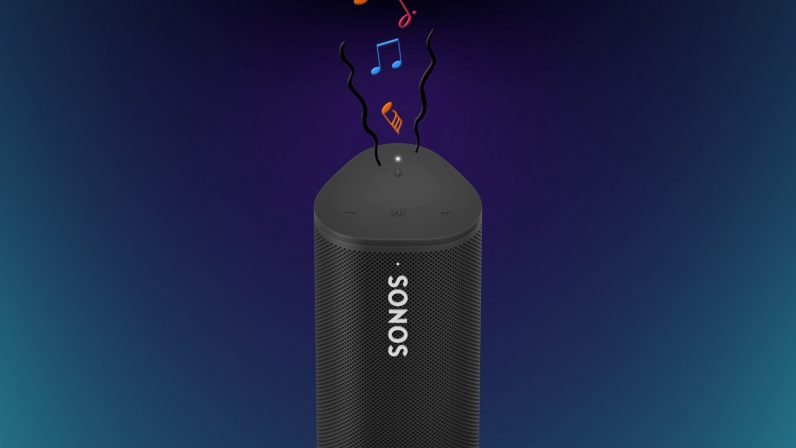
What about other audio features?
I’m a big fan of Trueplay. When the Sonos Roam’s mic is turned on, the device analyzes the space it’s in and changes the EQ depending on the environment. What this means is you don’t notice the sound of the speaker changing when you move about.
That sounds pointless, but is fantastic in practice. Anyone who’s taken a portable speaker into a shower only for the sound to boom irritatingly knows what I’m talking about.
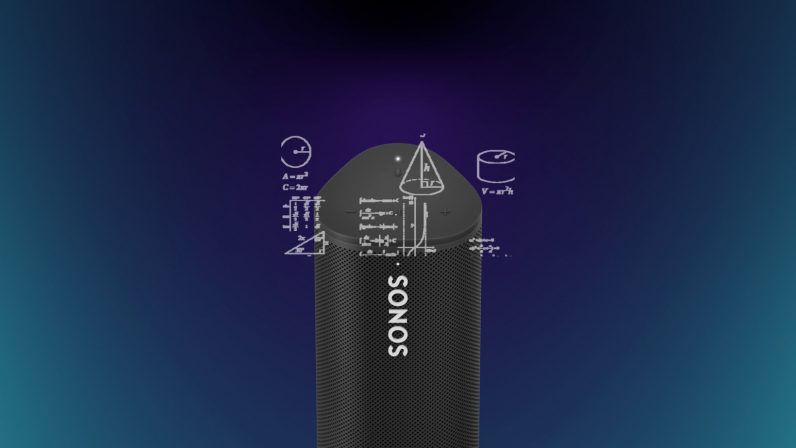
What’s the portable speaker like to use?
This used to be my big beef with Sonos systems: they were an arseache to set-up and use properly. In other words, the app was a bit shit. Fortunately, that experience is no longer so harrowing.
Yeah, there’s the occasional blip — I had problems pairing the Sonos Roam with my phone at first — but I’d say full setup only took a couple of minutes and since then it’s been smooth sailing.
Generally, I don’t tend to use the Sonos app to actually play music, but I sucked this up (I’m a hero) and found it worked well. I still find using AirPlay the easiest solution though.
Long story short, using the Sonos Roam is a dreamy breeze.

What about the negatives of the Sonos Roam?
There are a few. I’ve already mentioned the desire for more nuanced sound, as well as a bit more punch. Honestly, I think this could’ve been solved if Sonos made the Roam bigger.
It doesn’t need to increase its size much, but a few extra centimeters here and there could’ve delivered more power, larger speakers, and improved the battery life. It’s a bit of a lost opportunity.

Now let’s talk about shape. Earlier, I shared a picture of the Sonos Roam on its side. You can see the feet that enable this on the top left of the picture above.
On one hand, this is cool. I enjoy being able to lay the Sonos Roam down like this. The issue is that the speakers are only on one side of the device, meaning sound is pumped out from one direction.
In my mind, portable speakers in this mold operate better when they have a full 360-degree sound and can be planted in the middle of groups. I would’ve liked to see that from Sonos.
Then we have the price.
While $170 is broadly reasonable, it puts the Sonos Roam on the upper end of the portable speaker market. On balance, I think this is reasonable considering what you get, but it’s definitely not a bargain.
All of this leads us onto our next point…
Competitors
I mentioned at the start of this review that I’m a huge fan of portable speakers. Now, in the past few years my favorite has been the UE BOOM 3. This is an interesting point to raise because the two speakers complement each other in opposite ways.
Let me elucidate.
The Boom 3 is beefier than the Roam, which gives it a more powerful bass response, as well as a meatier, punchier sound. It’s also more rugged, delivers a true 360-degree sound, and you can currently pick it up for around $120 — a fair chunk cheaper than the Roam.
But the Sonos Roam is strong in a lot of the areas where the BOOM 3 struggles.
It looks more elegant, supports a wider range of playing methods, and can deliver more consistent sound with Trueplay. And, of course, it can link up seamlessly with an existing Sonos system.
Here’s an image for your enjoyment:
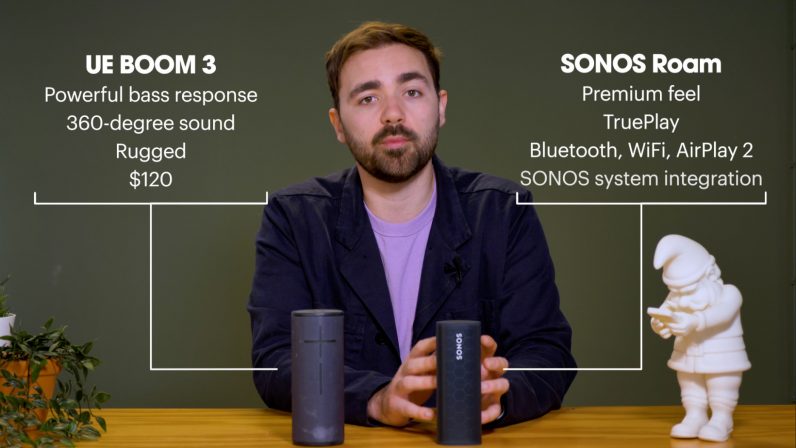
The reason I’m bringing this up is that I don’t believe a universally perfect portable speaker does, or can, exist. Products in this category will always be hamstrung by size constraints, meaning trade-offs are necessary.
What this means is you need to make a decision about what it is you want from a portable speaker.
For example, if you’re going to be using it mainly in rough-and-tumble outdoor environments, then the BOOM 3 or MEGABOOM is excellent. But if you’re after something that’ll be a bridge between the indoor and outdoor worlds, or already have a Sonos system, then it’s the Roam all day.
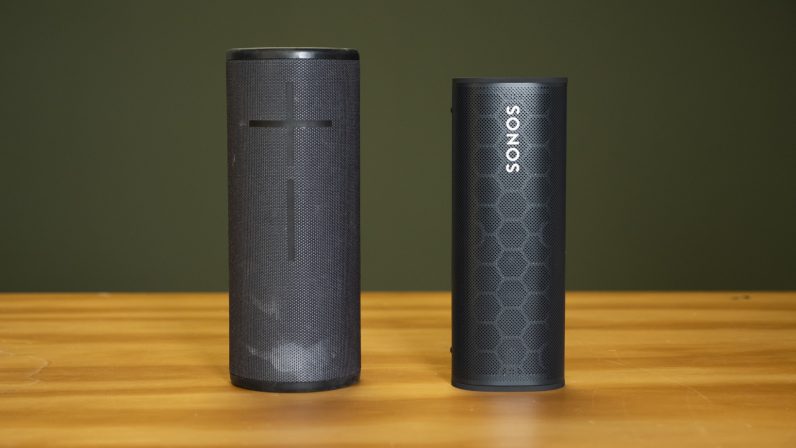
And this neatly gets us onto our final point…
The Sonos Roam is a shrewd business move
At the start of this piece, I referenced what clever business the Sonos Roam is — and this is due to one simple reason: it’s the ultimate entry-point into the Sonos world.
Let’s expand on that.
First off — and incredibly importantly — the Sonos Roam performs well enough as a standalone device to make it a genuine option for anyone looking for a premium portable speaker. This holds true whether you have, or are planning to have, a Sonos system.
Then consder that, ignoring the IKEA collaboration, it’s the cheapest Sonos speaker on the market.
Basically, the Roam acts as entrypoint into Sonos’ sales funnel — and without the pressure of having to go all-in on the system.

And that’s what’s so clever: Sonos has made the Roam both alluring and cheap enough to tempt a casual user. And if that person likes it? Well, it’s easy to get more Sonos gear involved and build out a collection.
Also, if you already have a Sonos system, there’s literally no reason why you wouldn’t buy a Roam if you were looking for a portable speaker.
It’s a win-win for the company.
The Roam either acts as an enticing lure to get people into its ecosystem, or a must have add-on for existing users. Clever. Very clever.
Conclusion
Look, the Sonos Roam isn’t a perfect portable speaker, but it is a very good one.
As discussed, the company had to make trade-offs in its construction, but the majority of them make sense. The only really criticism I have is the size. I think if the Sonos Roam was slightly bigger, this could’ve solved some of the issues I have with battery life and sound.
Despite all this, I’m most impressed by how clever a move this is from the company — and I’m intrigued to see if it drives more people into the arms of Sonos’ ecosystem.
Overall, the Sonos Roam is a terrific little speaker that does a lot of things very well. Let’s see what the company does next.
Get the TNW newsletter
Get the most important tech news in your inbox each week.

